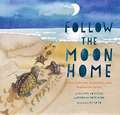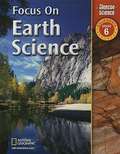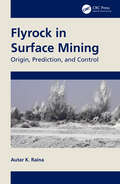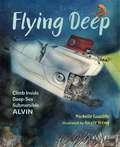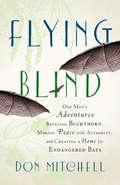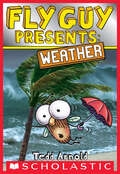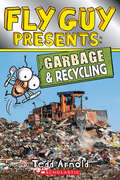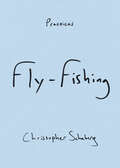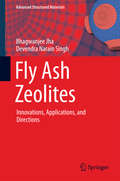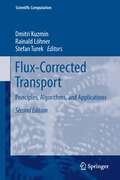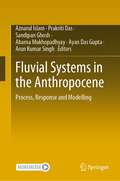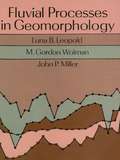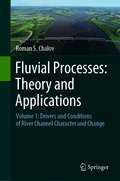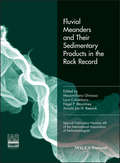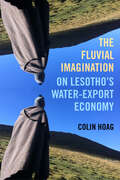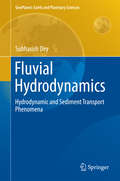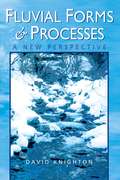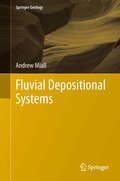- Table View
- List View
Follow the Water from Brook to Ocean
by Arthur DorrosExplains how water flows from brooks, to streams, to rivers, over waterfalls, through canyons and dams, to eventually reach the ocean. <P><P>[This text is listed as an example that meets Common Core Standards in English language arts for K-1 at http://www.corestandards.org.]
Follow the Moon Home: A Tale of One Idea, Twenty Kids, and a Hundred Sea Turtles
by Philippe Cousteau Deborah Hopkinson<P>Acclaimed activist Philippe Cousteau and renowned author Deborah Hopkinson team up to offer a story of the powerful difference young people can make in the world. <P>Meet Viv, who has a new home and a new school by the sea, and follow her as she finds her way in a new place and helps bring together a whole community to save the sea turtles of the South Carolina coast.
Folklore of American Weather
by Eric SloaneIn preparing this unusual book of American weather sayings and beliefs, Eric Sloane has made a painstaking effort to separate the true from the false, investigating origins and separating the many truly valuable pieces of weather lore from superstition, or what he calls "jackass jingles." As Mr. Sloane makes clear, folklore can be a very loose term used to cover a lack of knowledge of the very thing that folklore means: many things are passed off as folklore that are plain mistakes or inventions. Following general introductory remarks, Mr. Sloane has arranged his findings in an alphabetical folklore dictionary, enabling the reader to find readily the signs involving stars, wind, dew, rain, or whatever else he wishes. After each entry is a symbol indicating whether it is true (T), false (F), or possible (P). Thirty-five drawings by the author clarify and enhance the text of this entertaining and informative new book by America's favorite weather expert.
Focus On Earth Science (California)
by Juli Berwald Sergio A. Guazzotti Douglas Fisher Joseph J. Kerski Elizabeth A. Nagy-Shadman Donna L. Ross Julie Meyer Sheets Nancy Trautmann Jan Vermilye Dinah Zike National GeographicNIMAC-sourced textbook
Focus On Earth Science
by Mary Beth Abel Hughes James Sammons Patsy Eldridge Lynda PennellNIMAC-sourced textbook
Focus on Earth Science
by Cpo ScienceContains comprehensive content that introduces your students to key earth science concepts including energy, plate tectonics, weathering, earthquakes, volcanoes, and ecosystems. The text also integrates important ideas in science such as heat, density and buoyancy.
Flyrock in Surface Mining: Origin, Prediction, and Control
by Autar K. RainaThis book provides a comprehensive understanding of historical and recent research, with a critical review of several aspects of the flyrock phenomenon, along with classification of pertinent literature. This puts flyrock into proper perspective and develops a comprehensive regime for flyrock prediction and control. It also addresses the blast danger zone demarcation based on scientific understanding in comparison to the consequence-based approach supported by pertinent case studies. Features: Discusses exclusive material on flyrock in surface mining. Presents comprehensive and critical review of the flyrock phenomenon. Reviews prediction and control mechanisms in vogue with scientific and risk-based definitions of blast danger zone. Provides new insights into the flyrock definitions, prediction, and prevention along with the research approach to the problem. Includes Indian case studies and summarize global data available in the published domain. This book is aimed at researchers and graduate students in mining and civil engineering, engineering geology, and blasting.
Flying Deep: Climb Inside Deep-Sea Submersible Alvin
by Michelle CusolitoClimb aboard Alvin, the famous deep-sea submersible credited with helping to find the Titanic, and take a trip two miles down to the bottom of the ocean.Experience a day in the life of an Alvin pilot and join scientists at the seafloor to collect samples and conduct research. Along the way, discover what one wears, eats, and talks about during a typical eight-hour trip in a underwater craft and find out more about the animals that live deep in our oceans. Extensive back matter explains how Alvin works, describes the author's research, and includes a glossary and further reading."An appealing, exhilarating, and informative vicarious journey of discovery" —Kirkus Reviews, STARRED REVIEW"Wong&’s detailed illustrations add an exciting immediacy to the descent and to the glowing wonders of the deep&”—Washington Post
Flying Blind
by Don MitchellWhen Middlebury writing professor Don Mitchell was approached by a biologist with the Vermont Fish and Wildlife Department about tracking endangered Indiana bats on his 150-acre farm in Vermonts picturesque Champlain Valley, Mitchells relationship with bats--and with government--could be characterized as distrustful, at best. But the flying rats, as Mitchell initially thinks of them, launched him on a series of "improvements" to his land that would provide a more welcoming habitat for the bats--and a modest tax break for himself and his family. Whether persuading his neighbors to join him on a "silent meditation," pulling invasive garlic mustard out of the ground by hand, navigating the tacit ground rules of buying an ATV off Craigslist, or leaving just enough honeysuckle to give government inspectors "something to find," Mitchells tale is as profound as it is funny--a journey that changes Mitchells relationship with Chiroptera, the land, and, ultimately, his understanding of his own past. Ruminating on the nature of authority, the purview of the state, and the value of inhabiting ones niche--Mitchell reveals much about our inner and outer landscape, in this perfectly paced and skilled story of place.
Fly Guy Presents: Weather (Scholastic Reader, Level 2)
by Tedd ArnoldLearn all about weather with Fly Guy!It's time for a field trip! Fly Guy and Buzz are going to a weather station to learn all about weather. With straightforward text, humorous asides, and kid-friendly full-bleed photographs throughout, young readers will love learning about tornadoes, hurricanes, blizzards, and much more! Award-winning author/illustrator Tedd Arnold really brings nonfiction to life for beginning readers! And this book has eye-catching holographic foil on the front cover!
Fly Guy Presents: Garbage And Recycling (Scholastic Reader, Level 2 #12)
by Tedd ArnoldFly Guy is buzzing over to a landfill to learn more about garbage and recycling!Fly Guy and Buzz visit a landfill to discover where their garbage goes. They learn all about garbage trucks, trash sorting, bacteria, and how landfills can be more environmentally friendly. They also visit a recycling plant to learn about how recycling programs get started, the recycling cycle, and what happens when trash isn't properly disposed of. There are even tips for how readers can help keep our planet healthy! Award-winning author-illustrator Tedd Arnold brings nonfiction to life for beginning readers. There are humorous illustrations and engaging photographs throughout. The front cover features eye-catching holographic foil!
Fly-Fishing (Practices)
by Christopher SchabergIn Fly-Fishing, Christopher Schaberg ponders his lifetime pursuit of the widely mythologized art of fly-fishing. From the Michigan lakeshore where he learned to fish to casting flies in a New Orleans bayou, Schaberg sketches landscapes and fish habitats and shows how fly-fishing allows him to think about coexisting with other species. It offers Schaberg a much-needed source of humility, social isolation, connection with nature, and a reminder of environmental degradation. Rather than centering fishing on trophies, conquest, and travel, he advocates for a “small-fishing” that values catching the diminutive fish near one’s home. Introspective and personal, Fly-Fishing demonstrates how Schaberg’s obsession indelibly shapes how he understands and lives in the wider world.
Fly Ash Zeolites
by Bhagwanjee Jha Devendra Narain SinghThis book presents a thorough review of the state-of-knowledge and recent innovations in the synthesis of pure and improved grades of fly ash zeolites (FAZ). Addressing improvements to conventional methods, it also showcases a novel technique for the synthesis of high cation exchangers from fly ash and detailed characterization techniques for the products obtained. In addition, it examines in detail various areas of specific applications of fly ash zeolites. Over the years, several methods such as hydrothermal, fusion prior to hydrothermal, microwave assisted hydrothermal and molten salt techniques for producing FAZ have been developed. However, one-step and two-step reactions between the fly ash and alkali usually generate alkaline wastes that may cause environmental contamination. In addition, the separation of FAZ from the partially activated fly ash (the impurities) remains a major concern for researchers and industrialists alike. In view of these challenges, this book presents a novel technique for three-step activation (TSA), which focuses on recycling the fly ash-NaOH-water reaction by-products until zeolitic residue is formed. The FAZ (the final residue after third step reactions) synthesized in this manner exhibits exceptionally high cation exchange capacity, specific surface area and pore area. This book offers a comprehensive compendium of reading material on fly ash and its recycled product, the zeolites. Students at both undergraduate and graduate levels, researchers, and practicing engineers will all find this book to be a valuable guide in their respective fields.
Flux-Corrected Transport
by Dmitri Kuzmin Rainald Löhner Stefan TurekAddressing students and researchers as well as Computational Fluid Dynamics practitioners, this book is the most comprehensive review of high-resolution schemes based on the principle of Flux-Corrected Transport (FCT). The foreword by J.P. Boris and historical note by D.L. Book describe the development of the classical FCT methodology for convection-dominated transport problems, while the design philosophy behind modern FCT schemes is explained by S.T. Zalesak. The subsequent chapters present various improvements and generalizations proposed over the past three decades. In this new edition, recent results are integrated into existing chapters in order to describe significant advances since the publication of the first edition. Also, 3 new chapters were added in order to cover the following topics: algebraic flux correction for finite elements, iterative and linearized FCT schemes, TVD-like flux limiters, acceleration of explicit and implicit solvers, mesh adaptation, failsafe limiting for systems of conservation laws, flux-corrected interpolation (remapping), positivity preservation in RANS turbulence models, and the use of FCT as an implicit subgrid scale model for large eddy simulations.
Fluvial Systems in the Anthropocene: Process, Response and Modelling
by Aznarul Islam Prakriti Das Sandipan Ghosh Abarna Mukhopadhyay Ayan Das Gupta Arun Kumar SinghThis book addresses the various factors affecting fluvial systems, the processes governing them, system responses arising from human-nature interventions, and geospatial and geo-ecological modeling to understand system behaviour better and restore degraded ecosystems around the globe. Thanks to their hydrological and agro-ecological advantages, humans have settled along riverbanks since the dawn of civilization. Thus, the ancient "ecumene" (settlements) were located near major rivers worldwide. This legacy of river-based civilizations continues to this day in many forms. However, in the course of the 'Anthropocene' era, countless fluvial systems have been altered by human interventions in the form of large-scale dams and barrages, changes in land use and land cover, road-stream crossings, mining of sand and gravel, mushrooming of brickfield, expansion of modern agriculture, industrial growth, and urbanization. Thus, the present-day development pattern threatens fluvial systems, especially riverine morphology and ecosystems. In brief, human-induced morphological changes, water pollution, eutrophication, and related damages to aquatic organisms are the major threats to fluvial systems. Thus, maintaining the 'environmental flow' of the world's major rivers to preserve the proper functioning of riverine ecosystems and promote sustainable development is a global challenge.
Fluvial Processes in Geomorphology (Dover Earth Science)
by Luna B. Leopold John P. Miller M. Gordon WolmanThis excellent text is a pioneering work in the study of landform development under processes associated with running water. Its primary emphasis is on subjects that were the focus of the authors' studies in both field and laboratory. Part I deals with the process of change in the evolving landscape. Part II explores process and form, and Part III, the effects of time.In Part I, the relation of geomorphology to field problems is analyzed in studies of a mountain block in a semiarid climate, a meandering river cut into bedrock, and benches along a sea coast. Part Two contains studies of weathering, climate, and such denudational processes as flooding and erosion. Here, too, are examinations of the drainage basin as a geomorphic unit, water and sediment in channels, channel form and process, and hillslope characteristics and processes.In Part III, the authors cover geochronology, drainage pattern evolution, channel changes with time, and the evolution of hillslopes. Two appendixes will help readers convert units and equivalents, and identify symbols and nomenclature. 1964 edition.
Fluvial Processes: Volume 1: Drivers and Conditions of River Channel Character and Change
by Roman S. ChalovThis book presents an overview of the fluvial processes theory developed in the former USSR at Lomonosov Moscow State University for the last 50 years, following the famous manuscript by Professor Makkaveev in 1955. Even being published solely in the Russian language, the theory and the author of the book, Prof. Roman Chalov, are well known in the World. This book consolidates for the first time in English, Chalov's work for the global audience.The book demonstrates how principles from fluvial geomorphology and hydrology are used to develop an ecosystem approach to river analysis and management. Despite a strong tradition in fluvial geomorphology work in the USSR, unfortunately, little has been made of insights provided on the international stage. The fluvial processes theory accepted in USSR was somewhat isolated during the long period of development from the English-language literature. The studied rivers are mostly located in Northern Eurasia and much different from those described in classical English-language works. Chalov allows the readers to interconnect two Worlds in Geomorphology, building bridges between the classical international geomorphology and the equally in-depth and thorough but isolated research in the USSR.
Fluvial Meanders and Their Sedimentary Products in the Rock Record (International Association Of Sedimentologists Series)
by Massimiliano Ghinassi Luca Colombera Nigel P. Mountney Arnold Jan H. Reesink Mark BatemanThe sinuous form and peculiar evolution of meandering rivers has long captured the imagination of people. Today, meandering rivers exist in some of the most densely populated areas in the World, where they provide environmental and economic wealth and opportunities, as well as posing hazards. Through geological time, the ancestors of these modern meanders built deposits that are now host to mineral resources, groundwater, and hydrocarbons. This Special Publication illustrates the breadth of current research on meandering rivers and their deposits. The collection of research papers demonstrates the state of science on fluvial process–product relationships. The articles cover fundamental and applied studies of both modern and ancient rivers, are based on state-of-the-art technology, include complementary philosophical approaches, and span a wide range of spatial and temporal scales. This book includes some of the most recent advances in the study of the morphodynamics and sedimentology of meandering rivers, and is an important resource for those who want to investigate fluvial systems and their deposits.
The Fluvial Imagination: On Lesotho's Water-Export Economy (Critical Environments: Nature, Science, and Politics #12)
by Colin HoagA free open access ebook is available upon publication. Learn more at www.luminosoa.org. Landlocked and surrounded by South Africa on all sides, the mountain kingdom of Lesotho became the world's first "water-exporting country" when it signed a 1986 treaty with its powerful neighbor. An elaborate network of dams and tunnels now carries water to Johannesburg, the subcontinent's water-stressed economic epicenter. Hopes that receipts from water sales could improve Lesotho's fortunes, however, have clashed with fears that soil erosion from overgrazing livestock could fill its reservoirs with sediment. In this wide-ranging and deeply researched book, Colin Hoag shows how producing water commodities incites a fluvial imagination. Engineering water security for urban South Africa draws attention ever further into Lesotho's rural upstream catchments: from reservoirs to the soils and vegetation above them, and even to the social lives of herders at remote livestock posts. As we enter our planet's water-export era, Lesotho exposes the possibilities and perils ahead.
Fluvial Hydrodynamics
by Subhasish DeyThe state-of-the-art in fluvial hydrodynamics can be examined only through a careful exploration of the theoretical development and applied engineering technology. The book is primarily focused, since most up-to-date research findings in the field are presented, on the research aspects that involve a comprehensive knowledge of sediment dynamics in turbulent flows. It begins with the fundamentals of hydrodynamics and particle motion followed by turbulence characteristics related to sediment motion. Then, the sediment dynamics is analysed from a classical perspective by applying the mean bed shear approach and additionally incorporating a statistical description for the role of turbulence. The work finally examines the local scour problems at hydraulic structures and scale models. It is intended to design as a course textbook in graduate / research level and a guide for the field engineers as well, keeping up with modern technological developments. Therefore, as a simple prerequisite, the background of the readers should have a basic knowledge in hydraulics in undergraduate level and an understanding of fundamentals of calculus.
Fluvial Forms and Processes: A New Perspective
by David KnightonDavid Knighton's best-selling book looks at the wide range of forms developed by natural rivers and the processes responsible for that development. The book combines empirical and theoretical approaches, and provides a critical assessment of the many schools of thought which have emerged for dealing with adjustment in the fluvial system. It is fully illustrated throughout by a superb range of figures, photographs and tables.Starting with the network scale, the book examines the interaction of hillslopes, drainage networks and channels, and goes on to considerations of catchment hydrology and catchment denudation. Fluvial processes are analysed in detail, from the mechanics of flow to sediment transport and deposition. Detailing the major components of river channels, the book examines the nature of river adjustment, particularly with respect to equilibrium concepts, and concludes with a look at channel changes through time, affected by flood discharges, climatic change and human activities.
Fluvial Depositional Systems
by Andrew MiallThe book summarizes methods of mapping and interpretation of fluvial depositional systems, with a detailed treatment of the tectonic, climatic and eustatic controls on fluvial depositional processes. It focuses on the preserved, ancient depositional record and emphasizes large-scale (basin-scale) depositional processes. Tectonic and climatic controls of fluvial sedimentation and the effects of base-level change on sequence architecture are discussed. Profusely illustrated and with an extensive reference to the recent literature, this book will be welcomed by the student and professional geologist alike.
Fluvial Depositional Systems: Continuing Education Course Notes 20 (Springer Geology)
by Andrew MiallThis book is intended to complement the author's 1996 book "The geology of fluvial deposits", not to replace it.The book summarizes methods of mapping and interpretation of fluvial depositional systems, with a detailed treatment of the tectonic, climatic and eustatic controls on fluvial depositional processes. It focuses on the preserved, ancient depositional record and emphasizes large-scale (basin-scale) depositional processes. Tectonic and climatic controls of fluvial sedimentation and the effects of base-level change on sequence architecture are discussed. Profusely illustrated and with an extensive reference to the recent literature, this book will be welcomed by the student and professional geologist alike.

